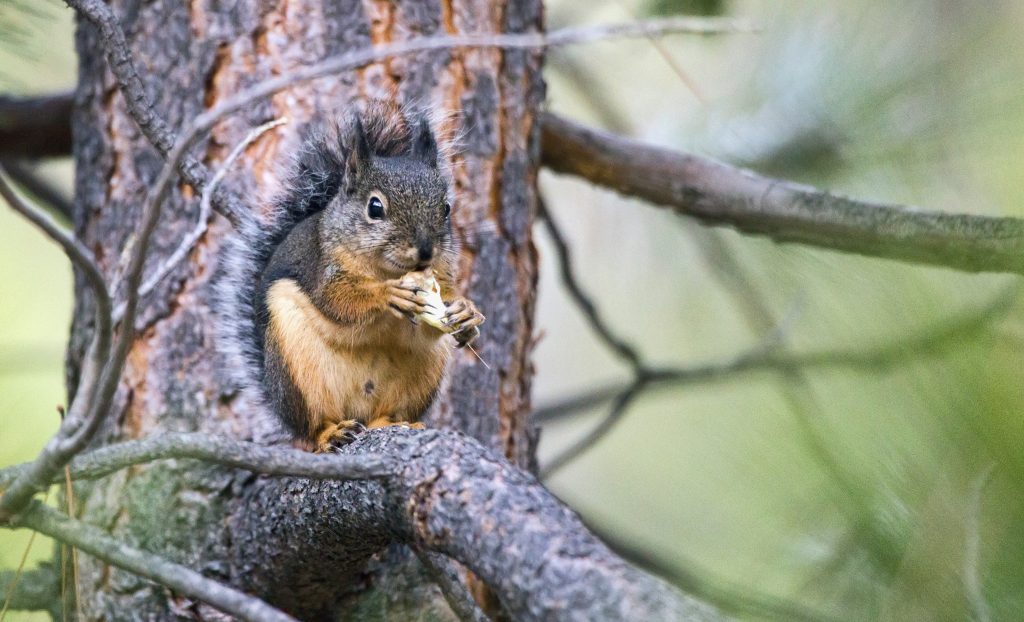Dr Chao Li – New Approaches for Increasing Woodland Growth
Understanding the factors that affect woodland growth can help researchers to develop sustainable forest management practices. This will ensure that society’s needs for forest products such as timber and pulp can be met, while also increasing carbon capture and providing important ecosystem services. Previous studies attempting to determine methods for achieving enhanced growth are inconsistent, leading to misconceptions among researchers and forest managers. Dr Chao Li and his team at the Canadian Forest Service aim to solve this problem by showing that a phenomenon called ‘compensatory growth’ can increase overall forest growth in the long-term. Through providing an enhanced understanding of compensatory growth and the factors affecting it, the forestry industry will be better equipped to meet increasing market demands, while also protecting the environment for future generations.
Understanding Forest Productivity
Human activity has led to increased demand for forestry products such as timber and pulp. If a forest cannot grow fast enough to meet these demands, problems can arise in the consumer market. Climate change and biodiversity loss are also becoming increasingly serious issues, meaning that it is now more important than ever before to maximise woodland growth in actively managed forests.
‘Forest productivity’ is a feature of individual units in a forest, which are called ‘stands’. Forest productivity is commonly defined as the whole volume of wood in a stand. However, some researchers prefer to think of it as a yearly increase in a stand’s wood volume. These varying definitions of forest productivity can cause inconsistencies and misconceptions amongst forestry professionals.
Gaining a more consistent and deeper understanding of forest productivity would allow such professionals to identify ways to increase the growth of their forests. By doing so, they would be able to increase future timber production and foster sustainable forest management. Additionally, increasing forest productivity could also aid the fight against climate change, because as they grow, trees absorb and store atmospheric carbon dioxide – the primary driver of global climate change.
Dr Chao Li and his colleagues at the Canadian Forest Service have been investigating the conditions needed to enhance the future growth of forests. Their work has resulted in an enhanced understanding of forest productivity and how to increase it, allowing foresters to meet consumer demands while also protecting the environment.

Thinning and Compensatory Growth
In a study published in 2018, Dr Li’s team investigated a forestry practice known as pre-commercial thinning, and explored whether this method, alongside fertiliser applications, can be used to enhance forest productivity.
Pre-commercial thinning involves cutting down some younger trees as a forest grows. This is performed because trees within a forest start to compete for resources such as light, space and nutrients as they grow larger, resulting in some trees dying. By thinning the forest of its younger trees, the remaining trees can enjoy increased resources, allowing them to grow much more quickly.
Although the individual remaining trees grow much faster after a thinning treatment, it was unclear how this practice affects the productivity of a forest stand as a whole. Dr Li explains that this gap in our knowledge is due to the slow growth of trees and the scarcity of long-term research trials, which has meant that studies evaluate the response of a forest for a relatively short period after thinning treatments.
‘To better support forest management decisions, we must fully evaluate whether pre-commercial thinning results in long-term advantages in forest growth relative to un-thinned sites,’ he says. ‘There are differing results in the literature, where inconsistent and even controversial results were obtained from different long-term thinning trials: some showed reduced forest productivity as a result of thinning, but others indicated increased forest productivity.’
To resolve this issue, Dr Li and his colleagues wished to find out whether the total volume of wood within a forest stand that had undergone pre-commercial thinning could match with – or even surpass – that of an un-thinned stand. The team refers to this phenomenon as ‘compensatory growth’. If thinning does lead to compensatory growth, they also wanted to understand the conditions under which it would happen, and how long it would take under various scenarios.
In their study, the researchers were able to reach beyond the usual short observation periods by revisiting a project that had been initiated by the Canadian Forest Service in the 1970s and is now cooperatively managed by BC Ministry of Forests, Lands, Natural Resource Operations and Rural Development. This initiative, called the Shawnigan Lake Project, focused on an area of 50 hectares, where Douglas-fir trees had been planted in 1948. In the 1970s, researchers had divided the forest into different study treatments. They then performed heavy thinning in some plots, light thinning in others, and no thinning in the remaining plots. In each plot, they also either applied a small or large amount of nitrogen fertiliser, or no fertiliser. In this way, the researchers achieved nine different unique combinations of conditions in their study plots.
Although the growth of trees in these plots had been measured in 2012, 40 years after the Shawnigan Lake Project had begun, the data had not yet been fully analysed. Dr Li wished to explore these measurements in depth to uncover the best combination of conditions for achieving maximum forest productivity.
His team’s analysis showed that under the same fertilisation regime, there were no significant differences between the wood volumes of the plots that had been thinned compared to those that had not. This means that although compensatory growth had allowed the thinned plots to catch up with the un-thinned plots, their wood volumes had not significantly surpassed those of the un-thinned plots.
However, adding fertiliser did seem to make a significant difference. Dr Li’s team found that the greatest increases in wood volume had occurred in the plots that had been given a large application of fertiliser 40 years prior. This was closely followed by the plots where a small amount of fertiliser had been applied.
In fact, the plots that had been given a large application of fertiliser alongside light thinning treatments had the largest wood volume. The team was also able to demonstrate that thinning leads to the remaining trees growing much thicker trunks over the study period. Such trees are far more valuable in terms of timber production than trees with slender trunks. Therefore, Dr Li recommends that light pre-commercial thinning is a good option when combined with the use of fertiliser. ‘The combination of pre-commercial and fertilisation treatments may represent untapped opportunities for enhancing wood fibre supply in managed forests,’ he says.
By investigating results collected on this experiment site in the 1990s, Dr Li and his colleagues found that complete compensatory growth had occurred in most of the thinned plots within 24 years.

Modelling Compensatory Growth
‘With all else being equal, such as weather, pests, disease, wildfires and even human pollution, pre-commercial thinning and fertilisation represents an opportunity to enhance timber supply,’ says Dr Li. ‘Since fertilisation was treated as a surrogate of site quality, the compensatory growth could be expected to speed up with improved site quality.’
In a more recent paper, Dr Li and his colleagues glean insights from hundreds of forestry studies, including those from the Shawnigan Lake Project, to gain a more complete picture of compensatory growth and its impact on overall forest productivity. By investigating the mechanisms that give rise to compensatory growth following a disturbance, such as thinning, they provide forestry professionals with a conceptual framework of this phenomenon, ways to predict it, and its relationship with forest productivity over time.
In this paper, the team also propose the development of a new model that can be used to identify the best conditions to maximize productivity, through the lens of compensatory growth. Such a model would include pre-commercial thinning and other factors that stimulate compensatory growth to predict the growth of surviving trees in a stand.
‘Our unified conceptual framework can thus serve as a foundation of developing predictive models of compensatory growth, for taking full advantage of it – as long as we can identify the conditions under which forest productivity could be enhanced,’ explains Dr Li.
‘The benefits of this new modelling approach is that it provides a powerful framework for evaluating how widespread compensatory growth is among species and forested ecosystems,’ he continues. ‘The flexible modelling framework allows for inputting species-specific data or inputs to quantify growth responses to various thinning regimes.’

The Work Continues
In their current project, Dr Li and his colleagues are working to further develop this model for predicting growth and yield, based on their conceptual framework of compensatory growth, to understand and predict forest dynamics of stands with different tree species at various geographic locations.
‘The direct applications of the model include the determination of optimal spacing in plantation programs, and optimal partial harvest operations leading to maximised management goals,’ says Dr Li.
In the future, Dr Li hopes that other researchers and forestry professionals can benefit from his model to determine the best approaches to leverage compensatory growth in their actively managed forests. If compensatory growth can be managed effectively, foresters will be able to enhance woodland growth, timber production, and carbon sequestration. This will help the forestry industry to meet increasing market needs, and may enable improved environmental performance in actively managed forests.
Reference
https://doi.org/10.33548/SCIENTIA710
Meet the researcher

Dr Chao Li
Canadian Wood Fibre Centre
Canadian Forest Service
Edmonton, Alberta
Canada
Dr Chao Li was trained in Entomology from Fudan University, and obtained his MSc in Mathematical Ecology from the Chinese Academy of Science, China. Dr Li then went on to earn his PhD in Insect Behavioural Ecology from Simon Fraser University, Canada, in 1993. Upon graduating, he worked as a Canadian Federal Government Laboratory Visiting Fellow at the Northern Forestry Centre in Canada, and as a Research Scientist at the Ontario Forest Research Institute. Over the past 24 years, he has held multiple roles at the Canadian Forest Service, including Knowledge Engineer, Physical Scientist, and Landscape Dynamics Research Scientist at the Northern Forestry Centre and Canadian Wood Fibre Centre. Dr Li has devoted his career to studying the effect of disturbances, both natural and anthropogenic, on forest dynamics, including with the IGBP-GCTE Landscape Fire Working Group on global impacts of fire. By enhancing forest productivity, he hopes to help meet human demands for wood products and contribute to a natural climate solution. Alongside his research, Dr Li also held positions as a Regional Coordinator of IALE-IUFRO Landscape Ecology Working Group (2007–2014) and IUFRO Landscape Ecology Working Party (2000–2014).
CONTACT
E: chao.li@canada.ca
W: https://cfs.nrcan.gc.ca/employees/read/cli
KEY COLLABORATORS
Hugh J. Barclay, Canadian Forest Service (retired)
Bernard D. Roitberg, Simon Fraser University
Robert G. Lalonda, University of British Columbia
Shongming Huang, Alberta Agriculture and Forestry
FUNDING
Sustainable Fibre Solution Program of Canadian Forest Service
FURTHER READING
C Li, H Barclay, B Roitberg, R Lalonde, Ecology and prediction of compensatory growth: from theory to application in forestry, Frontiers in Plant Science, 2021, 12, 5 655417.
C Li, H Barclay, B Roitberg, R Lalonde, Forest productivity enhancement and compensatory growth: a review and synthesis, Frontiers in Plant Science, 2020, 11, 575211.
C Li, S Huang, H Barclay, CN Filipescu, Estimation of compensatory growth of coastal Douglas-fir to pre-commercial thinning across a site quality gradient, Forest Ecology and Management, 2018, 429, 308.

Want to republish our articles?
We encourage all formats of sharing and republishing of our articles. Whether you want to host on your website, publication or blog, we welcome this. Find out more
Creative Commons Licence
(CC BY 4.0)
This work is licensed under a Creative Commons Attribution 4.0 International License. 
What does this mean?
Share: You can copy and redistribute the material in any medium or format
Adapt: You can change, and build upon the material for any purpose, even commercially.
Credit: You must give appropriate credit, provide a link to the license, and indicate if changes were made.
More articles you may like
Grandmothers: Innovation Through Tradition
Grandmother Project – Change through Culture (GMP) is an organisation dedicated to documenting the role of grandmothers and demonstrating the effectiveness of grandmother-inclusive strategies in improving the health and well-being of women, children, and adolescents. GMP’s groundbreaking work challenges conventional wisdom to transform community-based interventions in Africa and beyond, harnessing a powerful but often overlooked resource: the wisdom and influence of grandmothers.
Dr Robert Larkin | Cultivating Change to Improve Soil Health and Increase Potato Yield
Environmental quality and food production are facing the pressing challenges of climate change and global population growth. Dr Robert Larkin from the United States Department of Agriculture-Agricultural Research Service (USDA-ARS) and a team of plant scientists developed and tested a range of crop management systems to help overcome these compounding challenges. Their work is improving soil health and increasing the yield of potato crops, contributing to the future food security of nations.
Professor Giorgio Buttazzo | Artificial Intelligence and a Crossroads for Humanity
Where do we stand with artificial intelligence? Might machines take over our jobs? Can machines become conscious? Might we be harmed by robots? What is the future of humanity? Professor Giorgio Buttazzo of Scuola Superiore Sant’Anna is an expert in artificial intelligence and neural networks. In a recent publication, he provides considered insights into some of the most pressing questions surrounding artificial intelligence and humanity.
Dr Ralf Adam | New Technologies Shaping the Future of Oral Hygiene
Understanding the efficiency of various toothbrush technologies is essential for achieving optimal oral health. Dr Ralf Adam, who leads a dedicated team at Procter & Gamble in Germany, is keen to investigate the complexities of these technologies. His team have provided new insights into the best toothbrush types for plaque removal and the maintenance of gum health. By highlighting the importance of informed oral care decisions and ongoing investigations, this vital research works towards ensuring everyone can achieve a brighter, healthier smile.




